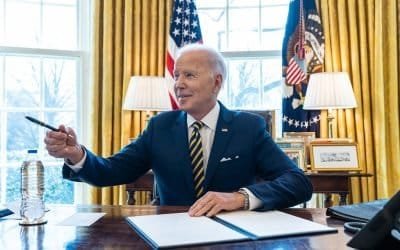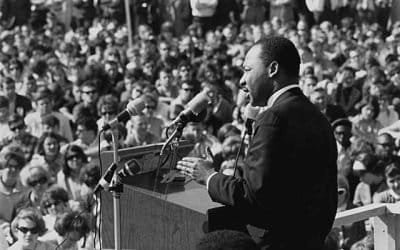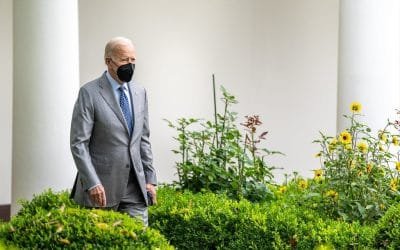Like three blind mice, Dick Gephardt, Hillary Clinton and James Carville are running around saying they want their eyes opened about what’s going on in this country about terrorism.
House Minority Leader Gebhardt wants an investigation into “what the White House knew about the events leading up to 9-11, when they knew it and, most importantly, what was done about it.” Hillary, after submissively watching from the White House as Islamicists attacked America in 1993, 1996, 1998 and 2000, suggests that Bush is asleep at the switch. Carville, echoing Gebhardt, asks, “What did the president know, when did he know it and what did he do about it?”
Let’s start with the “what did he do about it.” The two attacks on the World Trade Center came early in both the Clinton and Bush administrations, as sort of an Islamic Welcome Wagon.
With Clinton, it was only 37 days after his first inauguration when the 12:18 p.m. explosion rocked the World Trade Center on February 26, 1993, a blast that blew a crater five stories deep under Trade Tower Number One.
The 1,500 pound fertilizer-based bomb was intended to topple the taller tower of the World Trade Center into its twin tower, killing upwards of 40,000 people while simultaneously releasing a cloud of cyanide gas into the sky over Manhattan. Instead, the tower managed to stand and the heat of the explosion burnt the gas.
Displacing some 6,800 tons of material, the blast killed six, injured more than 1,000, forced the evacuation of 50,000 and produced $600 million in property damage. It was, at the time, the largest crime scene in NYPD history and the most significant act of international terrorism ever committed on U.S. soil.
On September 11, similarly, terrorists struck at the World Trade Center when George W. Bush was less than eight months into his presidency. FBI Director Robert Mueller had been in office one week.
In both cases, in 1993 and prior to September 11, no one denies that a whole lot of mistakes were made by American intelligence, a lot of signals missed, and a lot of dots, as they’re now saying at the FBI and CIA, were left unconnected.
What’s different about the two World Trade Center attacks is the way Clinton and Bush reacted. Bush hit back, seeing a war. Clinton backed off, seeing the attack as an incident that could best be handled in court, like a McDonald’s coffee spill.
Clinton advisor Dick Morris provides an insider’s view of how Bill Clinton reacted to the massive 1993 explosion, an attack, as noted by Kevin Duffy, the U.S. District Court judge who presided over the WTC-bombing trial, that caused “more hospital casualties than any other event in domestic American history other than the Civil War.”
Explains Morris: “Clinton never visited the site. Nothing so illustrates the low priority of terrorism in Clinton’s first term than the short shrift he gave the 1993 bombing of the World Trade Center. Several days after the explosion, while speaking in New Jersey, he actually discouraged Americans from ‘overreacting.'”
Clinton, not “overreacting,” downgraded the State Department’s Office of Counter-terrorism, ordered that the CIA shouldn’t recruit spies who weren’t certified good guys, and argued against offering a reward in the Trade Center bombing case, maintaining that it was an act of domestic terrorism and therefore not eligible for the International Terrorist Information Reward program.
The strategy, with the Clinton Justice Department maintaining that the bombing had no state sponsorship, was to prosecute the individual perpetrators of the bombing. On March 4, 1994, a jury found Mohammad Salameh, Ahmad Ajaj, Mahmud Abuhalima and Nidel Ayyad guilty, which did nothing, of course, to discourage another set of Mohammads and Mahmuds from joining the attack.
Bush, in contrast, recently told the graduates of United States Military Academy at West Point that the only strategy for an American victory against terrorism is to strike first: “If we wait for threats to fully materialize, we will have waited too long.”
And if we’re to win, it’s offense that’s required, he explained, not defense: “The war on terror will not be won on the defensive. In the world we have entered, the only path to safety is action. And this nation will act.”
And that, he said, means more than jury trials for individual perpetrators: “All nations that decide for aggression and terror will pay a price.” And it means more than restraint and appeasement: “Containment is not possible when unbalanced dictators with weapons of mass destruction can deliver those weapons on missiles or secretly provide them to terrorist allies.”
Not everyone, of course, is happy that America has decided to stop being a punching bag. Iran’s president says Bush is being too “bellicose,” North Korea says he has a bad case of “moral leprosy” and Irag is upset by his “sheer aggression.”
And, best of all, Madeleine Albright, Bill Clinton’s former Secretary of State, says Bush’s behavior is causing the “international community” to think that the U.S. is doing things “in an utterly disorderly way.” Good. It’s about time they start worrying about what we’re going to do.



